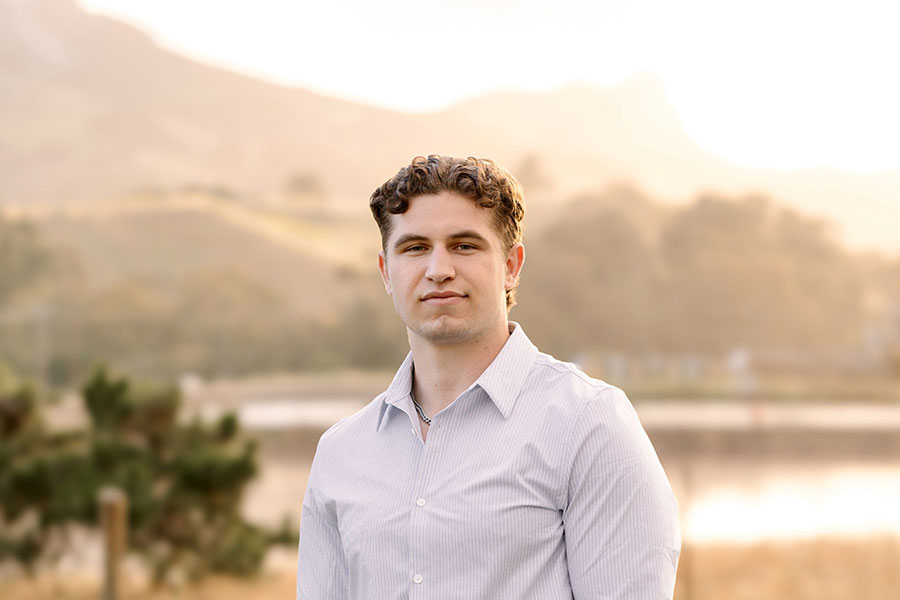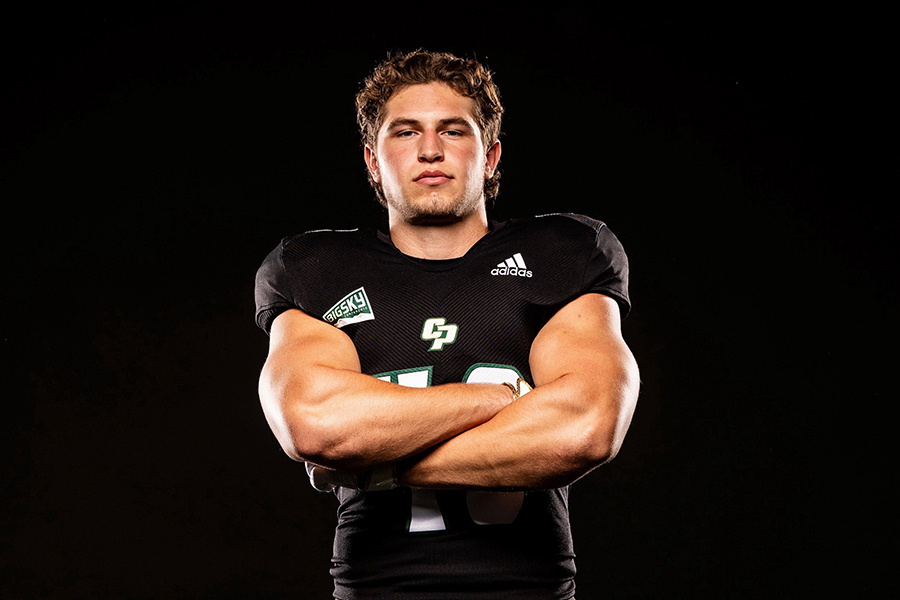Logan Foster: Researcher, Men’s Health Advocate, Aspiring Doctor
 Logan Foster is a first-generation college student who graduated with a degree in biological sciences in June. He was a Frost Research Scholar, football player, men’s health club organization leader and more.
Logan Foster is a first-generation college student who graduated with a degree in biological sciences in June. He was a Frost Research Scholar, football player, men’s health club organization leader and more.
July 2025 / NEWS STORY
by Anna Frias
Logan Foster is a recent biological sciences graduate with a minor in exercise and sports studies. He has delved deep into the Cal Poly student research programs, becoming a Frost Research Scholar, and earned a spot on Cal Poly’s football team as a junior. In the wake of earning his bachelor’s degree in June, he plans to pursue an MBA at Cal Poly and then move forward with medical school, with the goal of becoming a doctor.
Foster reflected on his Cal Poly undergraduate years as a student researcher, athlete, and advocate for improving local programs and communities.
What excited you about studying biology?
Coming out of high school, I didn’t really know what direction to go, but one of my favorite classes was AP Biology. I had an amazing teacher. I knew him well since his daughter was in my same year. As an athlete for most of my life, I’ve always been interested in understanding fitness and health. Anatomy and physiology were super interesting to me, and while there’s a lot of ecology or other sorts of plant science, what intrigued me most was definitely the human body.
Could you tell us a bit about how you got into research?
My organic chemistry teacher helped me out a lot. I didn't really know how to get involved and it sounded really interesting. My teacher told me to go write 20 emails to various professors, explore the different labs, and ask to sit in but don’t commit to the first lab you go to. I think I went to a different kinesiology professor’s lab, and he said he wasn't accepting any students, and he pointed me towards Dr. Todd Hagobian. His studies were all super interesting, and it seemed really connective to what I was learning in my studies to actual practice. I had been doing just research first for about two years and then my junior year, I heard about the Frost program and applied to be a Frost Research Scholar, which includes the year-round research requirement of 10 hours-plus per week as well as the Frost SURP (Frost Summer Undergraduate Research Program) and I was fortunate enough to do that as well.
By being a part of multiple research programs, did you ever find it challenging, having to change your mindset and almost start fresh with the new research projects?
It's definitely difficult. We had different meeting times throughout the week to address each one, and there was a lot of overlap. So, although I've been involved with all of them, usually students get prioritized on one study or another, so they can be more knowledgeable about the topic. I think we had 15 students in a research group, so three or four of them led the study, and the other ones came in and signed up for participant visits, and they didn't need to know about the study in as much detail. So, in that way, I led a couple of studies, and then I was able to help a lot with the other studies.
You mentioned you're a first-generation college student. What's that like, and how would you describe that experience?
I've actually been reflecting on that a lot recently because I just had to write my personal statement for medical school and it's the first time I had to really sit there and think about it. I noticed a lot of my family members and my colleagues said, ‘I'm surprised you don't really write about it a lot.’ To me, I don't see it as that big of a difference but the more I thought about it, the more I realized it really does define how I approach almost everything. I think I have a really different viewpoint on my time here in college than my colleagues. My parents had no guidance at all, and I don't know how they did it, but they weren't given anything and somehow came together and gave us the life they never had. So, I think I view my time here as just having a lot of opportunities that they never had. The privilege we have here, especially in the U.S. and then to have an opportunity to earn a college education, not a lot of people have that. So, I really try to take advantage of the opportunities I have.
Tell us about football. You were a high school football player. How did you envision playing in college?
I played all my life, since I was little. Then COVID hit, and that was kind of what ruined my junior and senior years and recruiting potential. I probably could have played at a Division 2 or Division 3 school, but I just always saw football as a way to get into a school too. I arrived at Cal Poly, started playing rugby, and found a great community. My coach knew a coach on the football team, and some of the coaches came out to our games every now and then, and I got recruited essentially. They told me I should come try out for the football team and I honestly was just thinking I might as well try. They ended up offering a position for a spot on the team and I thought I might as well. How could I turn that down?
What clubs or other extracurriculars have you participated in?
My buddy, Aziz Bassil, and I founded a club, the Men’s Health and Wellbeing Club. We felt that there was a lack of presence on campus for support tailored to men. I looked up organizations for men’s groups, and there wasn’t a single one besides athletics-based groups. There’s a big stigma with men talking about their mental health and we wanted to create a space where young guys can come into Cal Poly and find a good social group where they’re uplifting each other. Once a year, we do out of the dark campus walks (benefiting suicide prevention) that are partnered with the American Suicide Foundation and have helped raise money for them as a club.
I also was involved in the Cal Poly Red Cross Club and our pre-med club, AMSA. In my senior year, I was president of the Cal Poly Red Cross Club and have been involved for the past two years. I probably dedicated a few hundred hours to that club with the amazing things we do. We would host campus blood drives, attend regional advocacy and volunteer events, make care packages for our deployed military, and much more.





